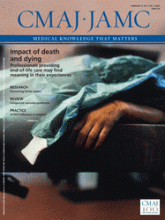What a difference a year makes. During pandemic (H1N1) 2009, primary care providers were scurrying around offices and clinics removing books and toys from waiting rooms, positioning bottles of hand sanitizer, passing out surgical masks to patients who presented with a cough or fever and using hospital-grade disinfectant to mop up floors when a suspected H1N1 case left their office or clinic.
They were, of course, following infection control guidelines established and recommended by the College of Family Physicians (CFPC) and a number of other groups during the height of the pandemic.
As the threat fades into memory, there’s an understandable tendency to hide the mops in the closet and leave the masks in the box.
But Ontario’s top infectious disease doctor is urging primary care providers to maintain aggressive infection prevention and control measures in their practices year-round.
Returning to business-as-usual would be a mistake, says Dr. Doug Sider, acting director of infectious disease prevention and control for the Ontario Agency for Health Protection and Promotion. “To recommend that we only consider more aggressive compliance with all of these infection prevention and control measures in the face of something like pandemic influenza, and then step back, relax our vigilance, relax our expectations, relax our urging to compliance at other times, just doesn’t make a lot of sense to me.”

Keeping the mops moving is good infection control for practice, even though the public health threat posed by pandemic (H1N1) 2009 has abated.
Image courtesy of © 2011 Jupiterimages Corp.
The CFPC has never developed infection prevention and control guidelines for standard family practice. Although it was one of the associations responsible for developing and issuing the guidelines during the pandemic (along with the Canadian Medical Association, the National Specialty Society for Community Medicine and the Canadian Public Health Association), those do not apply outside of a pandemic, says Jayne Johnston, the college’s communications manager.
The college doesn’t have a general infection control policy telling members how they should, or should not, run their practices on a day-to-basis, Johnston says.
But some of those recommendations would be good practice year-round, particularly as the flu season descends, says Sider, who suggests that primary care doctors always ensure staff is immunized with the seasonal flu vaccine and that standardized procedures be adopted for hand hygiene and the conditions in which masks should be used.
Sider also urges regular screening for febrile respiratory illness and depending on office design, the adoption of measures to contain its spread, such as asking patients who present with a cough and fever to sit in one part of the waiting room. As an alternative, staff can use a telephone triage system to screen for respiratory illness and then cluster those appointments near the end of the day, he adds. That would limit transmission and allow for the office to be sanitized properly before the next business day.
Such measures are a challenge for many family practices, Sider acknowledges. “It’s easy to say, but it’s really hard to put into place. Hospitals have environmental services people that can orient themselves with a lot of resources and a lot of sophistication. What do you do with a solo GP? Or even a multi-group practice?”
Infection prevention and control in Canada has been focused on acute care facilities as a consequence of rising rates of health care–associated infections, which are now estimated at 220 000 per year, according to a study conducted by members of the Canadian Hospital Epidemiology Committee, the Canadian Nosocomial Infection Surveillance Program and Health Canada.
While several provinces have created advisory committees and adopted measures aimed at reducing hospital-acquired infections and the Canadian Patient Safety Institute has rolled out a nationwide hand-hygiene campaign, most efforts have not been focused on health care facilities other than hospitals.
It’s problematic, explains Dr. Mark Joffe, senior medical director of infection prevention and control for Alberta Health Services. For one, Alberta Health Services can’t tell a doctor how to run his or her private practice, Joffe says. And with limited resources, it makes sense to concentrate on areas in the health-care system where infection can do the most damage, which historically has meant a focus on acute care hospital settings. But Joffe says that increasingly, there are “more and more people involved with infection prevention and control in continuing care or nursing homes. That’s a developing area.”
As well, the Canadian Patient Safety Institutes will be bringing its “wash your hands, wash your hands, wash your hands” message to primary- and home-care providers across the country, says CEO Hugh MacLeod. It will also release the findings of a research project into patient safety in primary care and aim to change the culture by encouraging patients to ask doctors about infection prevention and control measures. “They [doctors] shouldn’t be offended if someone says, ‘have you washed your hands?’” MacLeod says. “It’s making everybody safe. It’s in everybody’s best interest.”
While regulatory initiatives to implement infection prevention and control measures in the offices of family doctors are embryonic, at best, they are not entirely unheard of. The Alberta College of Physician and Surgeons, for example, has begun to conduct infection control audits of private practices.
Ward expects the college will proceed with some form of its infection prevention and control program in the coming months. “Infection prevention and control has not diminished in its importance, in the eye of the public, and the public health office and government. There is the ever-present threat of pandemic infections. We need to test everyone’s readiness for those events. Will physicians’ offices be safe places to visit during a pandemic? It will take a continuous educational campaign.”








